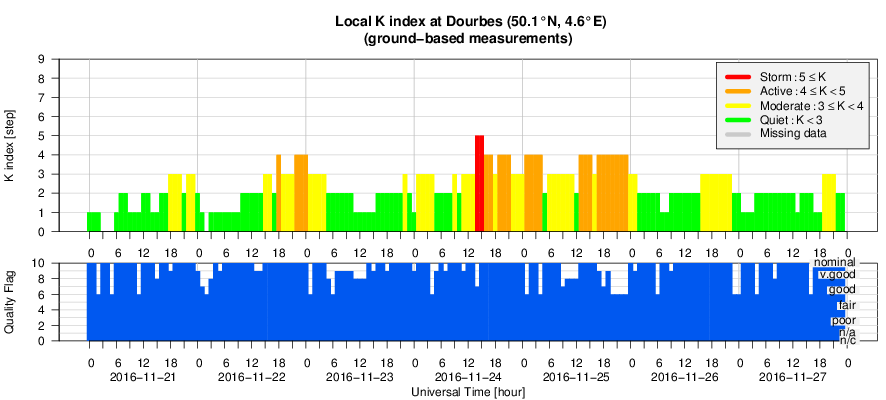- Table of Content
- 1.First radio bu...
- 2.Review of sola...
- 3.The Internatio...
- 4.PROBA2 Observa...
- 5.Review of geom...
- 6.Geomagnetic Ob...
- 7.Review of iono...
- 8.Future Events
2. Review of solar activity
3. The International Sunspot Number
4. PROBA2 Observations (21 Nov 2016 - 27 Nov 2016)
5. Review of geomagnetic activity
6. Geomagnetic Observations at Dourbes (21 Nov 2016 - 27 Nov 2016)
7. Review of ionospheric activity (21 Nov 2016 - 27 Nov 2016)
8. Future Events
First radio burst for ARCAS
On 24 November 2016 around 07:31UT, a brief brightening was observed in extreme ultraviolet imagery (EUV) from the Solar Dynamics Observatory (AIA094; top row images), indicating a small reconnection event. The related white-light images (bottom row) show that this reconnection took place near the southwest border of NOAA 2612's main sunspot. See the imagery underneath, with the indicated timings for AIA094.
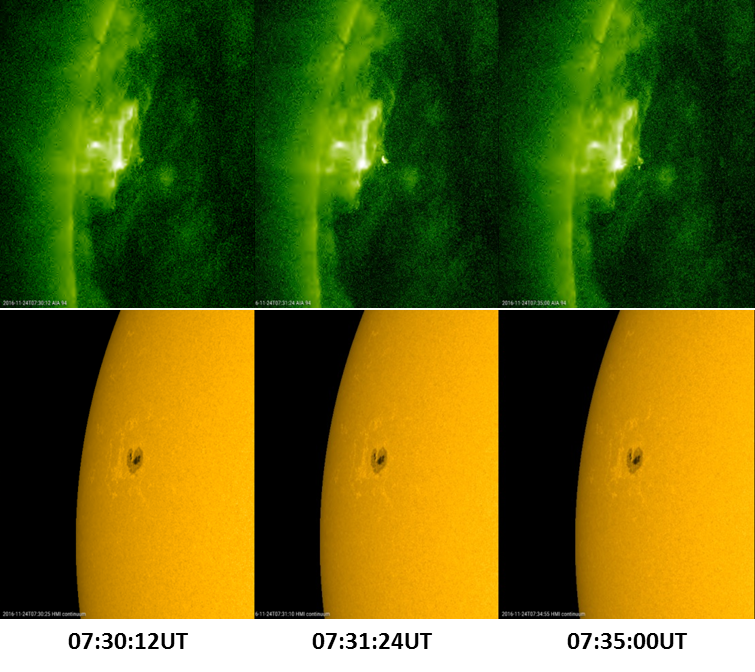
The event left no obvious x-ray signature (no flare), however radio observations indicated that it was related to a type III radio burst. A type III radio burst is produced by a stream of electrons accelerated (usually during an eruptive event) and propagating out in the solar corona along open magnetic field lines. These electrons typically travel at a fraction of the speed of light c (about 0.3 c, or 90.000 km/s).
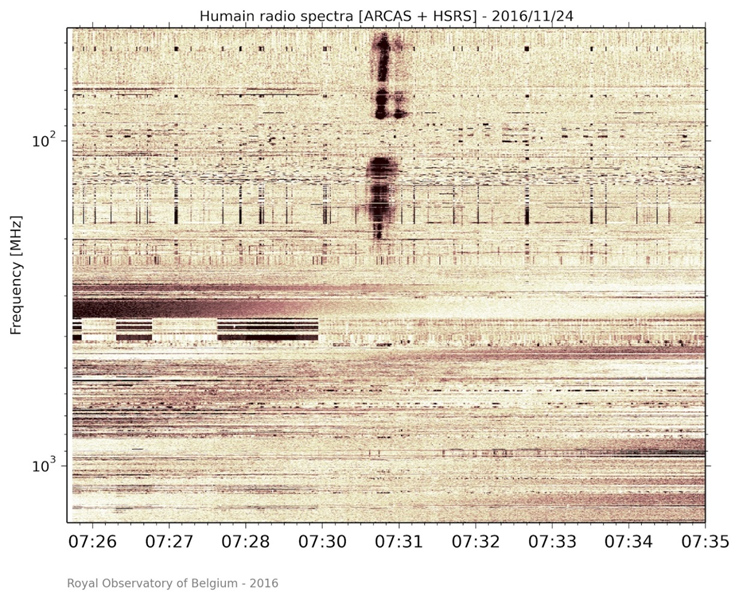
The picture above is a radiospectrum that combines observations from ARCAS (45 – 275 MHz in this plot) and HSRS (275 – 1495 MHz), both radio receivers at the Humain Solar Radio Observatory. The frequency scale is plotted on a logarithmic scale (vertical axis) and decreasing upward. We see soon after 07:30 UT a group of type III bursts, lasting less than a minute. The interruption of the burst around 100 MHz is due to a filter that attenuates the FM band that would otherwise interfere with the receiver.
What makes this observation special is that it’s the first clear solar radio burst observed with ARCAS, a new radio spectrometer installed at the Humain Observatory late October. ARCAS (Augmented Resolution Callisto Spectrometer) is a digital spectrometer based on a Software Defined Radio receiver configured to scan the band 45 - 450 MHz. It has been set up on 27 October 2016, in parallel to the Callisto receiver already in operation at Humain. Both instruments share the same receiving antenna via a splitter. ARCAS improves the frequency coverage of Callisto and gives access to frequency bands that were difficult to observe so far. It is also about 4 times faster than Callisto.
The folks at Humain are still in the "commissioning" phase of this instrument, and thus eagerly awaiting more solar activity to assess the new toy's performances. With the very low solar activity ongoing, it is already a miracle to have caught this small group of type III bursts. More near real-time radiospectra can be found at http://www.sidc.be/humain/humain_spectra_realtime.php
Review of solar activity
Solar activity was very low, with no C-class flares observed during the week. SILSO reported a spotless Sun on 21 and 22 November. The active regions (ARs) present on the visible disk were NOAA AR 2611 (mostly spotless), 2612 (largest region), and 2613 (near the end of the week). Proton levels remained low and there were no earth-directed coronal mass ejections (CMEs).
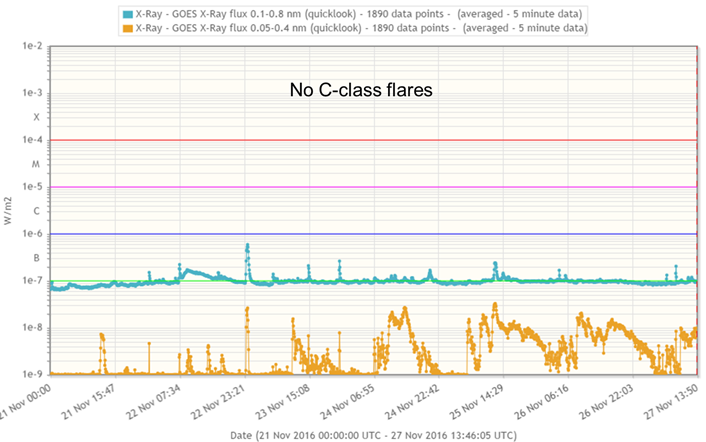
A polar and an equatorial coronal hole rotated into an earth-affecting position by 22 November. They both had a positive (outward directed) magnetic field. Their area had significantly decreased compared to the previous Carrington rotation (see image comparison underneath).
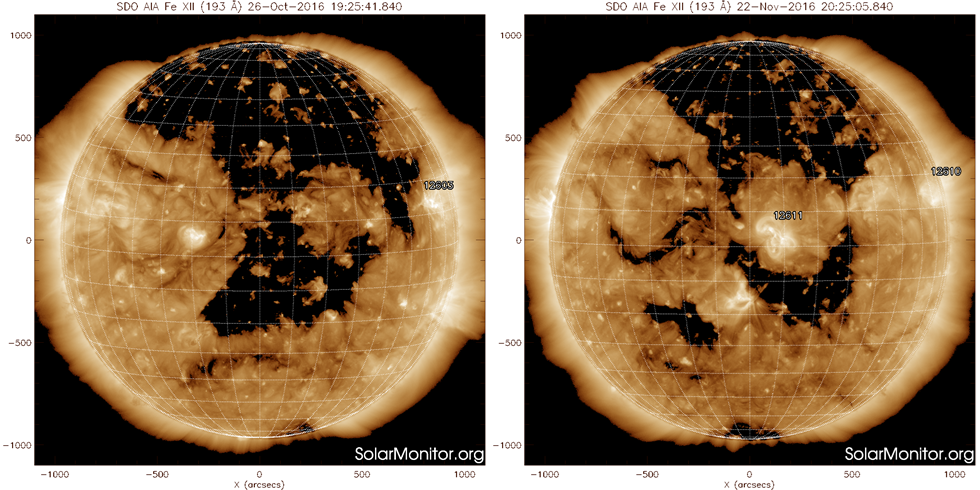
The International Sunspot Number
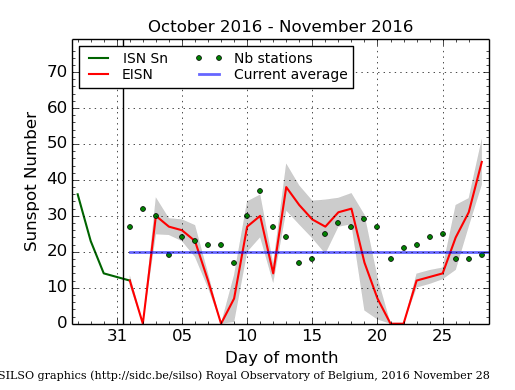
The daily Estimated International Sunspot Number (EISN, red curve with shaded error) derived by a simplified method from real-time data from the worldwide SILSO network. It extends the official Sunspot Number from the full processing of the preceding month (green line). The plot shows the last 30 days (about one solar rotation). The horizontal blue line shows the current monthly average, while the green dots give the number of stations included in the calculation of the EISN for each day.
PROBA2 Observations (21 Nov 2016 - 27 Nov 2016)
Solar Activity
Solar flare activity remained very low during the week.
In order to view the activity of this week in more detail, we suggest to go to the following website from which all the daily (normal and difference) movies can be accessed: http://proba2.oma.be/ssa
This page also lists the recorded flaring events.
A weekly overview movie can be found here (SWAP week 348).
http://proba2.oma.be/swap/data/mpg/movies/weekly_movies/weekly_movie_2016_11_21.mp4weekly_movie_2013_12_30.mp4
Details about some of this week's events, can be found further below.
If any of the linked movies are unavailable they can be found in the P2SC movie repository here
http://proba2.oma.be/swap/data/mpg/movies/weekly_movies/weekly_movie_2016_11_21.mp4weekly_movie_2013_12_30.mp4
Sunday Nov 27
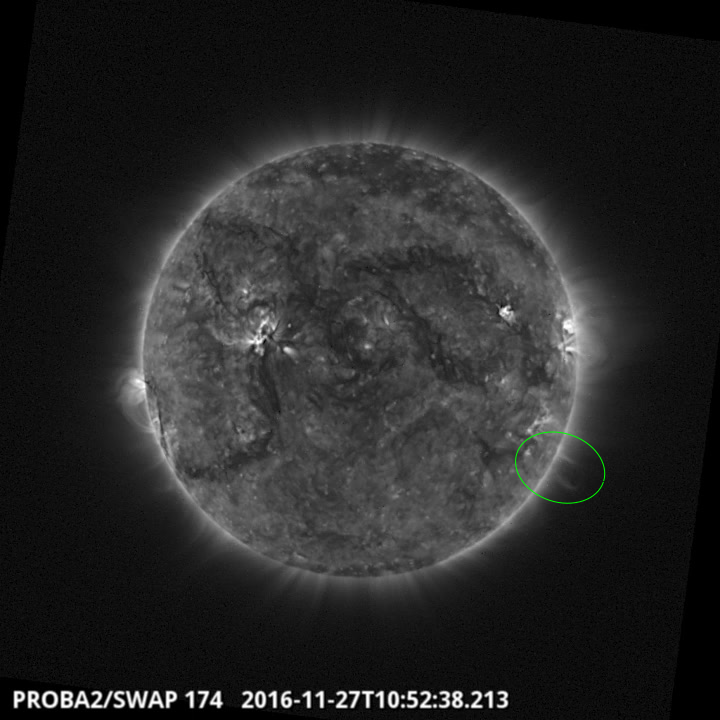
An eruption was observed by SWAP on the west limb of the Sun on 2016-Nov-27 at 10:52 UT
Find a movie of the event here (SWAP movie)
http://proba2.oma.be/swap/data/mpg/movies/20161127_swap_movie.mp4
Review of geomagnetic activity
Geomagnetic conditions were dominated by high speed stream (HSS) effects from 22 November onwards until the end of the week. Solar wind speeds reached 750 km/s (purple curve) with interplanetary magnetic fields up to 12 nT (black curve) and mostly oriented away from the Sun (blue curve).
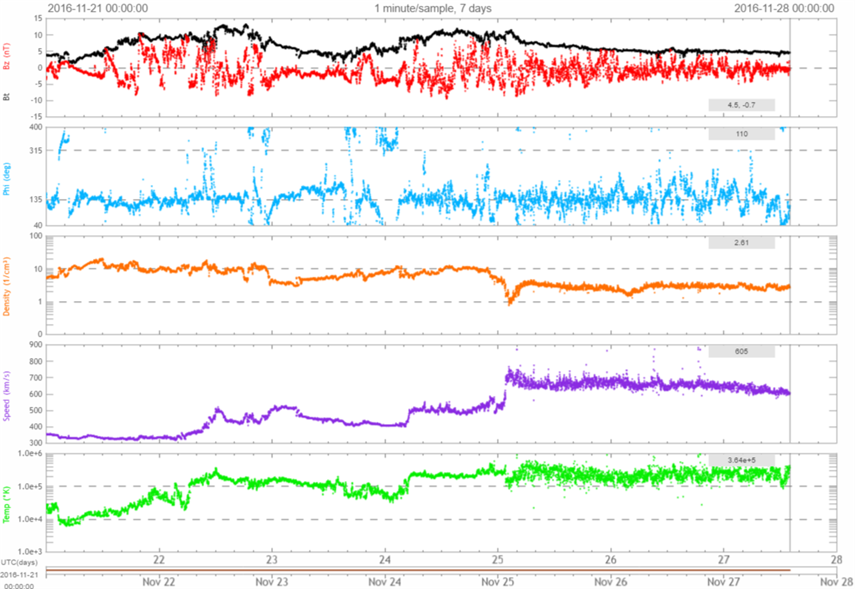
Unsettled to minor storm conditions (K Dourbes from 3 to 5) were observed from 22 November until 27 November, with Kp at a single moderate storming episode on 25 November. The influence of the HSS from these coronal holes (CH) was significantly less than during the previous solar rotation, in part because of the CH's smaller size. See the comparison of Kp indices underneath.
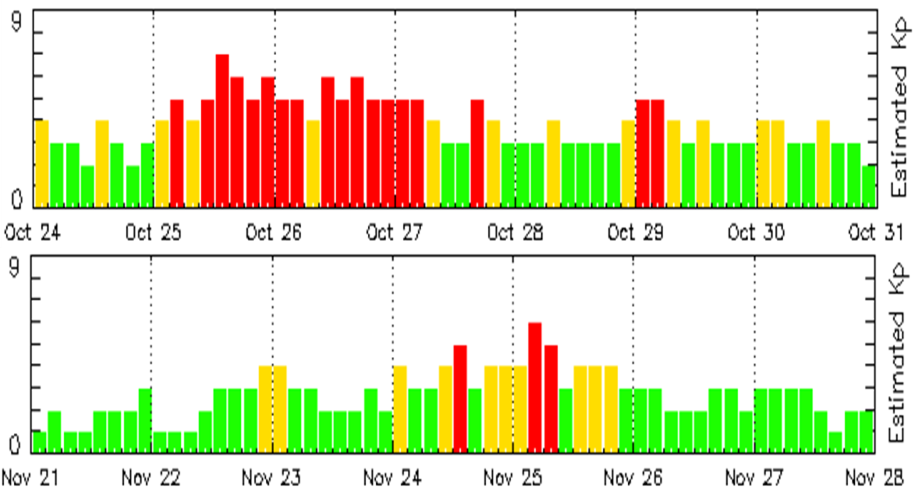
Review of ionospheric activity (21 Nov 2016 - 27 Nov 2016)
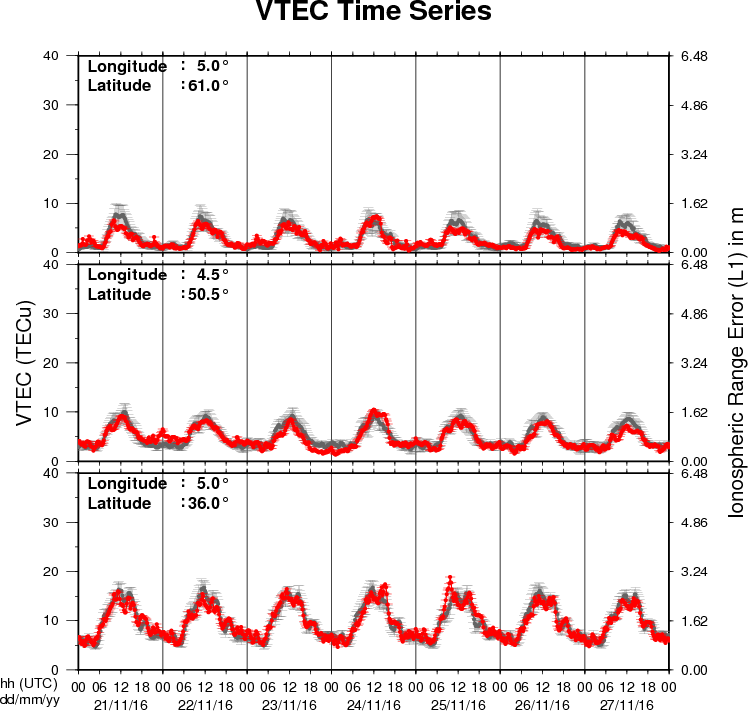
The figure shows the time evolution of the Vertical Total Electron Content (VTEC) (in red) during the last week at three locations:
a) in the northern part of Europe(N61°, 5°E)
b) above Brussels(N50.5°, 4.5°E)
c) in the southern part of Europe(N36°, 5°E)
This figure also shows (in grey) the normal ionospheric behaviour expected based on the median VTEC from the 15 previous days.
The VTEC is expressed in TECu (with TECu=10^16 electrons per square meter) and is directly related to the signal propagation delay due to the ionosphere (in figure: delay on GPS L1 frequency).
The Sun's radiation ionizes the Earth's upper atmosphere, the ionosphere, located from about 60km to 1000km above the Earth's surface.The ionization process in the ionosphere produces ions and free electrons. These electrons perturb the propagation of the GNSS (Global Navigation Satellite System) signals by inducing a so-called ionospheric delay.
See http://stce.be/newsletter/GNSS_final.pdf for some more explanations ; for detailed information, see http://gnss.be/ionosphere_tutorial.php
Future Events
For more details, see http://www.spaceweather.eu/en/event/future
4th SOLARNET Meeting: The Physics of the Sun from the Interior to the Outer Atmosphere, in Lanzarote (Spain)
Start : 2017-01-16 - End : 2017-01-20
The IV SOLARNET MEETING 'The physics of the Sun from the
interior to the outer atmosphere' will take place in Lanzarote
(Spain) from 16th to 20th of January 2017, organized by the
Instituto de AstrofÃsica de Canarias (IAC).
SOLARNET (High-resolution Solar Physics Network) is an EU-FP7
project coordinated by IAC with the aim of bringing together and
integrating the major European research infrastructures in the
field of high-resolution solar physics. SOLARNET involves all
pertinent European research institutions, infrastructures, and data
repositories. Networking activities, access to first-class
infrastructures and joint research and development activities are
being covered under SOLARNET to improve, in quantity and quality,
the service provided by this European community.
The purpose of this conference is to provide a coherent picture
of the Sun as a single physical system playing all the underlying
physical processes measured and observed in the solar atmosphere to
date.
Website:
http://www.iac.es/congreso/solarnet-4meeting/
Solar Orbiter Workshop 7: Exploring the solar environs in Granada, Spain
Start : 2017-04-03 - End : 2017-04-06
This event will be hosted by the Instituto de Astrofisica de
Andalucia - CSIC. Please mind that on April 7th the 20th SWT
meeting will take place at the same venue.
Website: Unkown
